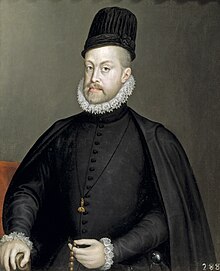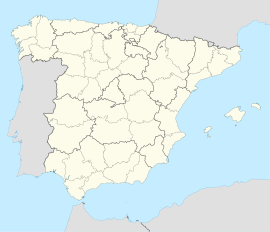User:Cmateotrad/sandbox
Church of San Antonio (Aranjuez)
| |
|---|---|
| Location | Spain |
| Criteria | Cultural: ii, iv |
| Reference | 1044 |
| Inscription | 2001 (25th Session) |
| Coordinates | 40°02′11″N 03°36′34″W / 40.03639°N 3.60944°W |
The Aranjuez Cultural Landscape (Spanish: El Paisaje Cultural de Aranjuez) is located in the town of Aranjuez, Community of Madrid, Spain. It includes the Royal Palace of Aranjuez, the Island Garden, the urban area — geometrically organised — and the Prince's Garden.
This Cultural Landscape contains a series of market gardens, wooded promenades, agricultural landscapes and the Natural Reserve The Regajal-Sea of Ontígola — in which a butterfly reserve can be found. It was added to the UNESCO's World Cultural Heritage list in 2001. [1]
Description

The sophisticated Aranjuez Cultural Landscape, which derives from different sources, marks an initial period in the desing development of this landscape. It represents the union of certain cultural influences to create a cultural landscape. This one had a formative influence over the evolution on this field.
Aranjuez has seen, during a period of time, several cultural exchanges in a specific cultural area. This cultural area has had a strong influence both the development of the monument and the creation of its landscape.
Aranjuez represents a model for the particular culture of its area. Yet the city has become more and more vulnerable since the disappearance of the Real Audiencia in the early years of the century, which had such an important influence in its development.
This area is characterized by a long history of human settlements before becoming into a strategic fortress in the Roman Age, located by a river crossing (the Tagus and the Jarama) and at a crossroads, in south Madrid and northwest Toledo.
By the end of the 14th century, the knights had already built a palace in the woods. But it was Philip II of Spain in the 16th century who created the first period of splendour. A new palace was built, with large ornamental and vegetable gardens, made using geometrical principles. It was also a private and personal place for ease. During the 17th century, Aranjuez became the annual residence of the royalty and a place to show off and hunt. It was source of inspiration for the difussion of some of the greatest Spanish poets of the Spanish Golden Age.
History

Before it became a strategic fortress in Roman times, the city of Aranjuez had seen a large number of human settlements. Afterwards, its location by a river crossing and at a crossroads – which was influential on several occasions – played an important role in the political geography of that period. Aranjuez was located in a sparsely populated region. Because of that it was finally granted to the Order of Santiago by the Crown in the Medieval Era. Towards the end of the 14th century, a palace was built by the knights in the woods.[2]
Aranjuez became a royal site in the 15th century, but it was king Philip II in the 16th century who created the first period of splendor. The city was also a private and personal retreat.
The period of splendor continued throughout the

After a brief resurgence, which found expression in modernity and
During the Revolution of 1868, the Crown’s property came under the State’s control and eventually, all that was left of Aranjuez in 1870 were pieces of their former property. Meanwhile, the increase in population and the construction of a railway line (1851) stimulated enormous economic activity. During the 20th century, Aranjuez became a satellite city with high population density of Madrid, and an industrial and cultural center in which its own memory and maintenance started deteriorating. However, it generally maintains its integrity, and there is growing a sense of respect and new attitudes towards the city.[4]
Monuments

- The herrerian. Its white façade is decorated with the statues of the three kings who took part in the construction of it.
- Parterre’s Garden is located in front of the façade of the palace and it is an English garden. Inside there can be seen the fountain of Hercules and the fountain of Nereids. There is also the small garden of the statues formed by 14 busts from Roman emperors and ancient celebrities.
- The Prince’s Garden was built by Charles IV and covers 150 hectares among the Queen Street and the River Tagus. The railings and chinescos (a type of gazebo that is found in the chinescos pond, chinescos is a word to express the style of the chinese gazebo) were built by Villanueva and the master gardener Boutelou took care of the rest. The splendid fountains representing Narciso and Apollo are important monuments made in Carrara marble.
- Farmer’s House: Charles IV, while being Prince of Asturias, ordered its construction in a corner of the Prince’s Garden, surrounded by magnolias, maples and Tilia. Its style is neoclassical and it was designed and intended as a recreational place. It also hosts paintings by Bateu, Gonzalez Velasquez, and Lapelli and an important collection of sanctuary objects. The “Platinum Office” is exceptionally luxurious and sumptuous.
- Infante’s House: Chares III ordered Juan de Villanueva its construction as the new accomodation for the family of his children, the Infants Gabriel and Anthony. It is a very functional building. It is part of a square, which is the connection point between the old quarter and the palace.
- The House of the Knights and Professions: The House of the Professions dates back to the 17th century and the House of the Knights dates from the 18th century. They are two beautiful buildings which are connected to the palace by a terrace. Its purpose was to be a home for the government of the Royal Site and to host the entourage during Royal meetings.
- Marine House was built to keep the boats used by the Kings during Spring. Nowadays there are some “falúas reales” (a type of recreational longboard) inside, among other interesting nautical objects from the time of Charles III.
- Convent of San Pascual is an impressive building byFrancisco Sabatini, composed of a church and a convent. The façade of the convent is neoclassical and two towers crown it. The church has a Latin cross floor plan with chapels.[5]
See also
- Royal Palace of Aranjuez
- Aranjuez Gardens
- Aranjuez
References
External links
- Aranjuez Official Web (in Spanish)
- History and Description (in Spanish)

